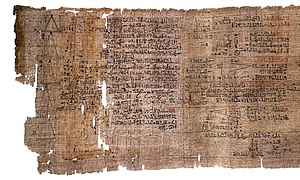Rhind Mathematical Papyrus
| Rhind Mathematical Papyrus | |
|---|---|
| British Museum, London | |

A portion of the Rhind Papyrus
|
|
| Date | Second Intermediate Period of Egypt |
| Place of origin | Thebes |
| Language(s) | Egyptian (Hieratic) |
| Size | Length: 536 centimetres (211 in) Width: 32 centimetres (13 in) |
| Other | BM/Big no. AE 10058, Reg no. 1865,0218.3 |
The Rhind Mathematical Papyrus (RMP; also designated as papyrus British Museum 10057 and pBM 10058) is one of the best known examples of Egyptian mathematics. It is named after Alexander Henry Rhind, a Scottish antiquarian, who purchased the papyrus in 1858 in Luxor, Egypt; it was apparently found during illegal excavations in or near the Ramesseum. It dates to around 1650 BC. The British Museum, where the majority of papyrus is now kept, acquired it in 1865 along with the Egyptian Mathematical Leather Roll, also owned by Henry Rhind; there are a few small fragments held by the Brooklyn Museum in New York City and an 18 cm central section is missing. It is one of the two well-known Mathematical Papyri along with the Moscow Mathematical Papyrus. The Rhind Papyrus is larger than the Moscow Mathematical Papyrus, while the latter is older than the former.
The Rhind Mathematical Papyrus dates to the Second Intermediate Period of Egypt. It was copied by the scribe Ahmes (i.e., Ahmose; Ahmes is an older transcription favoured by historians of mathematics), from a now-lost text from the reign of king Amenemhat III (12th dynasty). Written in the hieratic script, this Egyptian manuscript is 33 cm tall and consists of multiple parts which in total make it over 5m long. The papyrus began to be transliterated and mathematically translated in the late 19th century. The mathematical translation aspect remains incomplete in several respects. The document is dated to Year 33 of the Hyksos king Apophis and also contains a separate later historical note on its verso likely dating from the period ("Year 11") of his successor, Khamudi.
...
Wikipedia
